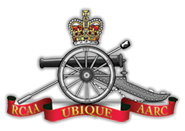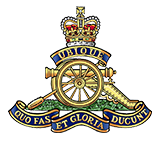The First World War 1914-18
Of approximately 44,000 Gunners who enlisted during the First World War, some 38,000 served overseas. The remainder served in depots, coast batteries and as instructors at the Gunnery Schools. By the end of the war in 1918, Canada had produced for service five divisional artilleries, an army field brigade, an anti-aircraft battery and three brigades of garrison artillery (including two heavy batteries). The RCHA Brigade, first under Lieutenant-Colonel H. Panet and later under Lieutenant-Colonel W.H.P. Elkins, was part of the Canadian Cavalry Brigade. This brigade served in the Canadian Corps and also in the Indian and British Cavalry Corps. Two Canadian field batteries served in North Russia and one in Siberia, fighting the Bolsheviks into 1919, and a coast defence company garrisoned the Island of St Lucia in the British West Indies.
The main armaments used by Canadian Gunners during the war were the 13 Pdr with the RCHA; the 18 Pdr and 4.5-inch howitzer in the field artillery; the “turned up” 13 Pdr mounted on a truck in the anti-aircraft artillery; and 60 Pdr, 6-inch, 8-inch and 9.2-inch heavy guns in garrison, heavy and siege artillery companies. By the end of the war, each Divisional Artillery also had heavy trench mortar batteries using 9.45-inch mortars and medium trench mortar batteries with 6-inch Newton mortars.
The Ypres Salient, the Somme, Passchendaele, Amiens, Arras, Cambrai and Mons mark the road of the Canadian Gunners 1915-18, but none of their battles is more famous than Vimy Ridge in April, 1917. It is safe to say that no British offensive up to that time was as carefully planned as the attack by the Canadian Corps. The offensive is described here as an example of the artillery battle during the Great War 1917-18.
Experience at the Somme had shown the necessity of thorough artillery preparation against strong defences, though this time there was no intention of trying to demolish all of the enemy’s trenches. Except in the foremost areas, instead of totally destroying the German wire entanglements, the fire of medium guns with the use of the newly introduced No.106 instantaneous fuze on high explosive shells would cut lanes through the wire for the assaulting infantry. The preliminary bombardment would be directed against trench junctions, concrete machine-gun emplacements, strongpoints, tunnel entrances and dugouts. In the rear, road junctions, ammunition dumps and light railways would receive particular attention. Harassing fire had proved its value at the Somme and it would now be employed each night to ensure that the enemy’s relieving troops or carrying parties could use no avenue of approach to their trenches with impunity.
Counter battery work, the organization and development of which was due largely to the efforts of Lieutenant-Colonel (later General) A.G.L. McNaughton, would seek out and neutralize hostile guns to an extent far greater than in any previous operation. This was possible as result of improved techniques in locating the enemy’s batteries, better liaison between the artillery and the assaulting infantry and an increased efficiency and accuracy of fire in the batteries detailed to silence the German guns. Overall command of the artillery in the operation was vested in the General Officer Commanding Royal Artillery (GOC RA), Canadian Corps, Brigadier E.W.B. “Dinky” Morrison, who had won his DSO at Leliefontein.
The Canadian Corps Heavy Artillery at Vimy consisted of eighteen heavy batteries, twenty-six medium batteries, nine 60 Pdr batteries, and two batteries of 6-inch Mark VII guns which formed into eight Siege Groups and three Counter Battery Groups. All heavy artillery was under the command of Brigadier R.H. Massie, who exercised that command through the four Double Group Commanders with respect to the Siege Groups and through Lieutenant-Colonel A.G.L. McNaughton in control of the three Counter Battery Groups. Total heavy artillery at the Corps level numbered one hundred and four 6-inch howitzers, thirty-six 8-inch howitzers, thirty-six 9.2-inch howitzers, four 12-inch howitzers, three 15-inch howitzers, fifty-four 60 Pdr guns and eight 6-inch guns.
The Commanders Royal Artillery (CRAs) of the four Canadian divisions, in addition to their own respective artilleries, had under their command a number of British artillery formations for the operation. These included four more divisional artilleries, seven army field artillery brigades (i.e. regiments) and a brigade of the RHA. The total amount of field artillery available to the four divisions numbered four hundred and eighty 18 Pdrs, twenty 13 Pdrs (A & B Batteries RCHA with C and K Batteries RHA), and one hundred and thirty-eight 4.5-inch howitzers together with twenty-four 9.45-inch trench mortars.
Canadian Corps Artillery Instruction No. 1 for the capture of Vimy Ridge, a 35-page document issued by Brigadier Morrison’s headquarters, divided the artillery battle into four distinct phases. The first two of these would consist of preparatory bombardments. In the initial phase (March 20 – April 2), there would be a general increase in activity where only 50% of the heavy batteries and a portion of the divisional artilleries would reveal themselves. To aid in this concealment, the registration and calibration of heavy batteries, not intended to be disclosed until later, would take place under cover of pre-arranged bombardments.
The second phase (up to the day of the assault) would see the total available artillery come into action. During this period, in addition to the destruction of wire, trenches, strongpoints and hostile batteries, eight villages within or immediately beyond the area to be assaulted would be subjected to the most intense bombardments. The village of Thélus, lying between the Red and Blue Lines (objective lines on the right side of the ridge) would receive special treatment from four heavy howitzer batteries, and the British 12- and 15-inch super howitzers. 180 12-inch and 270 15-inch rounds were allotted for this task, almost completely obliterating the village. Included in the second phase were two feint barrages to throw the enemy off guard as well as to practice the barrage lines and detect any errors in calculations.
The third phase was the bombardment in support of the assault, comprising of rolling and standing barrages and counter battery fire. The rolling barrages would be fired in lifts of 100 yards to allow the advancing infantry to move forward under cover of fire. The standing barrages would concentrate on certain specified trenches and defensive systems. Silent batteries would be positioned forward on the right to support the attack against distant targets on the wider part of the ridge.
The fourth phase of the artillery fire plan provided for the movement of field batteries behind the infantry once the latter had captured their objectives, in order to provide defensive fires. Heavy artillery would also have to move forward to provide counter battery fire, with their observers taking advantage of the direct observation that would now be available from the summit of the ridge overlooking the Douai Plain.
During the first phase, over 85,000 rounds of heavy and 190,600 rounds of field ammunition were fired. During the second phase (2-8 April), a period called by the enemy “the week of suffering”, an unceasing flow of shells of all calibres poured over the heads of the Canadians in the forward trenches. By the morning of the assault (9 April), more than a million rounds, with a total weight of 50,000 tons had battered the German positions into a cratered wilderness. The counter battery fire – 125,900 rounds in the week before 9 April – silenced 83% of the German guns.
During the assault itself, in addition to their own guns, Canadian Gunners put into action nine captured enemy artillery pieces. The Vimy operation remains a classic example of the deliberate break-in against strongly prepared positions, and of the ability of the assaulting forces to consolidate and hold what they had gained. Vimy set a new standard in the artillery’s readiness to deal effectively with strong enemy counter-attacks after the infantry’s successful capture of their objectives.
A stunt that Canadian Gunners would use with effect during the Second World War may have originated at Vimy as a defence against German counter battery measures. It was known that the German artillery was using a prominent church spire behind the Canadian lines as a registration point. The tower was carefully dismantled one dark night and then rebuilt exactly as it had been before, but on a new site far enough away to throw all guns registering on it several degrees off their targets.
The price of victory during the First World War was high. Of the 59,544 Canadian battle fatalities, 2,031 were Gunners. The addition of 534 artillerymen who died of disease, injury or accident brought the total Canadian artillery fatalities to 2,565. Another 8,066 Gunners were wounded or injured, bringing total casualties for The Regiment to 10,631: almost 28% of the total men who went overseas. Only the infantry suffered higher casualties in the War.
The war of 1914-1918 would contribute significantly to the growth and efficiency of The RCA. The intimate cooperation between artillery and infantry, which is the first requisite of modern war, found no better example than in the productive relationship which existed between the Gunners and their supported arms within the Canadian Corps. The Corps Commander, Lieutenant General Sir Arthur Currie, himself a Gunner, sought at all times to exploit gun power to the limit for the purpose of saving infantrymen’s lives. In the final two years of the war, when the serious shortage of artillery ammunition no longer existed, Canadian Gunners were unsparing in their expenditure of ammunition to give the assaulting infantry adequate support, with their motto being to always fire the “ultimate round”.


